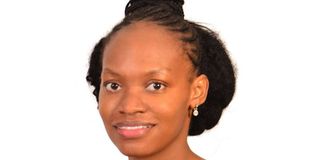Cutting her niche in STEM a day at a time

Ms Tanya Faraj a standards officer at the Kenya Bureau of Standards. She is one of the notable examples of women leaders in the country who have cut their niche in Stem.
What you need to know:
- Ms Faraj is a standards officer at the Kenya Bureau of Standards (Kebs) a job that entails developing standards for testing quality of products in the mechanical and electrical meteorology disciplines.
- She has a degree in Physics from Jomo Kenyatta University of Science and Technology.
- Got a scholarship to study for a Master in Nuclear and Radiation Engineering course at the University of Alexandria, Egypt.
- She is a a founding member of Kenya Women in Physics Association.
Ms Tanya Faraj has some vivid childhood memories with electrical appliances.
“Growing up, I was the girl that tried to fix the faulty electrical appliances in the house,” says Ms Faraj with a chuckle.
Now aged 30, she is building a career that is no further from ensuring equipment powered by electricity are in good working condition.
Ms Faraj is a standards officer at the Kenya Bureau of Standards (Kebs) a job that entails developing standards for testing quality of products in the mechanical and electrical meteorology disciplines.
Her rise is an example of a mix of talent, passion and hard work.
“I’m so happy I finally got to do what I was cut out to do. I really enjoy my work,” says Ms Faraj who was born and raised in Mombasa.
Upon completing her studies at Sheikh Khalifa Secondary School, Ms Faraj joined Jomo Kenyatta University of Science and Technology (JKUAT) for a degree in Physics.
Internship
In January 2013, she joined the Ministry of Energy for a nine-month internship pending graduation in July, same year.
Here, she put her best foot forward as she learnt new concepts on nuclear physics under her then supervisor Dr David Otuoma, to whom she credits her success.
Her sterling performance paid off.
Upon expiry of her internship, she says Dr Otuoma and the then Chief Executive Officer of National Commission for Science Technology and Innovation (Nacosti) recommended her for a scholarship to study for a Master in Nuclear and Radiation Engineering course at the University of Alexandria, Egypt.
She studied for two years and returned to Kenya in 2016 then joined Kebs as a non-destructive testing (NDT) officer.
It took her just two years to be elevated to a standards officer sitting at the standards development and trade department.
Testing standards
Here, she teams up with technical experts to come up with testing standards, an exercise that takes approximately 18 months.
“Everything I do involves skills drawn from training on physics,” she says, “For instance, non-destructive testing used in mechanical engineering depends on physics principles. I am so happy my parents supported me to nurture my love for physics and mathematics,” she says.
Ms Faraj has a different view to reducing gender disparity in enrolment of boys and girls in Science, Technology and Engineering and Mathematics (Stem) courses. She is one of the notable examples of women leaders in the country who have cut their niche in Stem.
However, the number of women in Stem fields is low, compared to their male counterparts.
Young age
According to the Commission for University Education (CUE), 33 per cent of the students pursuing Stem courses are female, representing just a third of the largely male-dominated sphere.
For her, girls should never be induced into Stem courses. Instead, they should be self-driven and be ready to follow their career journey from childhood to adulthood.
“You can tell the interests of a child from a very young age by what she or he does,” says Ms Faraj.
“If a child is inclined to business, public speaking, poetry or music, as a parent or guardian, we should support them and not force them to do what we want or what the society prefers for them. Let a child do what he or she loves or is comfortable doing.”
Founding member
Currently, Ms Faraj is the vice-chairperson of Physics Society of Kenya. She previously served as the treasurer of the Eastern Africa Association of Radiation Physics.
She is also a member of Organising Women in Science for Developing World in addition to being a founding member of Kenya Women in Physics Association.
“Every opportunity I get, I make sure I inspire a girl to be the best in whatever she loves doing,” she says.
“I am here today because of the many mentors who held my hand throughout my journey and I always endeavour to hold another girl’s hand too.”





